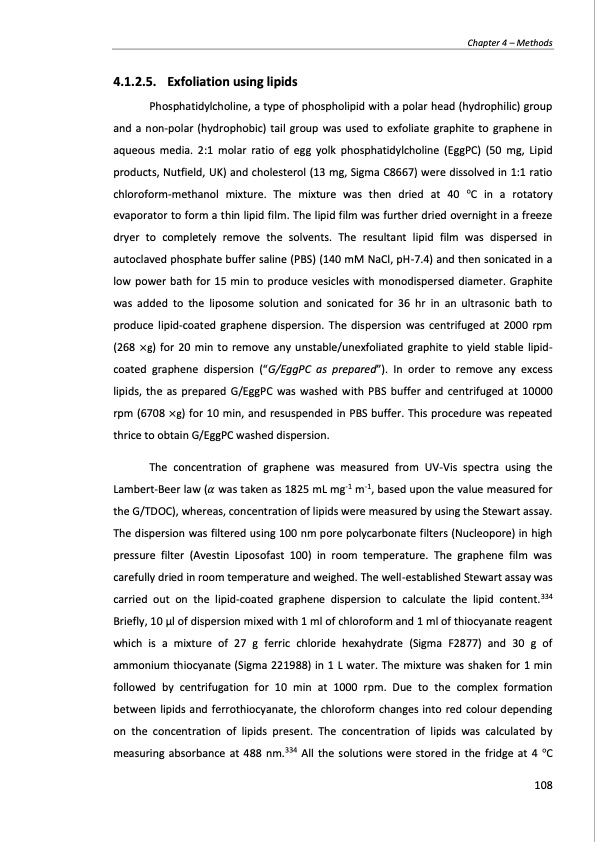PDF Publication Title:
Text from PDF Page: 108
4.1.2.5. Exfoliation using lipids Phosphatidylcholine, a type of phospholipid with a polar head (hydrophilic) group and a non-polar (hydrophobic) tail group was used to exfoliate graphite to graphene in aqueous media. 2:1 molar ratio of egg yolk phosphatidylcholine (EggPC) (50 mg, Lipid products, Nutfield, UK) and cholesterol (13 mg, Sigma C8667) were dissolved in 1:1 ratio chloroform-methanol mixture. The mixture was then dried at 40 oC in a rotatory evaporator to form a thin lipid film. The lipid film was further dried overnight in a freeze dryer to completely remove the solvents. The resultant lipid film was dispersed in autoclaved phosphate buffer saline (PBS) (140 mM NaCl, pH-7.4) and then sonicated in a low power bath for 15 min to produce vesicles with monodispersed diameter. Graphite was added to the liposome solution and sonicated for 36 hr in an ultrasonic bath to produce lipid-coated graphene dispersion. The dispersion was centrifuged at 2000 rpm (268 ×g) for 20 min to remove any unstable/unexfoliated graphite to yield stable lipid- coated graphene dispersion (“G/EggPC as prepared”). In order to remove any excess lipids, the as prepared G/EggPC was washed with PBS buffer and centrifuged at 10000 rpm (6708 ×g) for 10 min, and resuspended in PBS buffer. This procedure was repeated thrice to obtain G/EggPC washed dispersion. The concentration of graphene was measured from UV-Vis spectra using the Lambert-Beer law (𝛼 was taken as 1825 mL mg-1 m-1, based upon the value measured for the G/TDOC), whereas, concentration of lipids were measured by using the Stewart assay. The dispersion was filtered using 100 nm pore polycarbonate filters (Nucleopore) in high pressure filter (Avestin Liposofast 100) in room temperature. The graphene film was carefully dried in room temperature and weighed. The well-established Stewart assay was carried out on the lipid-coated graphene dispersion to calculate the lipid content.334 Briefly, 10 μl of dispersion mixed with 1 ml of chloroform and 1 ml of thiocyanate reagent which is a mixture of 27 g ferric chloride hexahydrate (Sigma F2877) and 30 g of ammonium thiocyanate (Sigma 221988) in 1 L water. The mixture was shaken for 1 min followed by centrifugation for 10 min at 1000 rpm. Due to the complex formation between lipids and ferrothiocyanate, the chloroform changes into red colour depending on the concentration of lipids present. The concentration of lipids was calculated by measuring absorbance at 488 nm.334 All the solutions were stored in the fridge at 4 oC Chapter 4 – Methods 108PDF Image | PRODUCTION AND APPLICATIONS OF GRAPHENE AND ITS COMPOSITES

PDF Search Title:
PRODUCTION AND APPLICATIONS OF GRAPHENE AND ITS COMPOSITESOriginal File Name Searched:
graphene-production-applications.PDFDIY PDF Search: Google It | Yahoo | Bing
Salgenx Redox Flow Battery Technology: Power up your energy storage game with Salgenx Salt Water Battery. With its advanced technology, the flow battery provides reliable, scalable, and sustainable energy storage for utility-scale projects. Upgrade to a Salgenx flow battery today and take control of your energy future.
CONTACT TEL: 608-238-6001 Email: greg@infinityturbine.com (Standard Web Page)